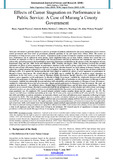| dc.description.abstract | Inter-ethnic conflicts impact negatively on the economic growth. In Africa, it has cost the Continent a tune of $ 120 billion, specifically affecting the agricultural sector subjecting over 198,000,000 people to starvation and food insecurity. Government effort in addressing the issue has been in vain as the number of deaths continued to rise tremendously from an estimate of 7, 9 and 13 people in 2012, 2014 and 2016 respectively. Further, massive destruction on property since 2012 has increased the rate of poverty, illiteracy, insecurity and communicable diseases. This has raised the concerns about the government’s ability in mitigating the vice. Previous studies in Kenya have focused on relationships between inter-ethnic conflicts, power and sharing of government resources. However, little research has been done on interethnic conflicts with stability, security, mobility and morbidity. The objective was to determine the relationship between inter-ethnic conflicts and economic growth in Nyando, Muhoroni and Tinderet sub-counties. Conflict theory as propounded by Karl Marx was adopted. A cross-sectional survey design and a population of 220 were used. It was a census study with response rate at 80.7%. The results revealed that there is significant association between inter-ethnic conflicts and economic growth using Pearson product moment correlation (r=.740, p=.00). Inter-ethnic Conflicts had an effect on economic growth and accounted for 58.1% significant variance in economic growth (R square =.581, F (2, 217) =261.296, p=.000). Finally, the main strategies used for conflict management were peace building activities, resettling clash victims and organizing workshops and seminars for the affected. The study recommends that all stakeholders ranging from the national government, the lands commission, the community leaders/elders, and the British government which colonized Kenya be engaged in finding a lasting solution to land issues. Besides these, the National Cohesion and Integration body should cascade its structures down to local councils to counter incitements, hate speech, and ethnicity. The national government should demobilize, rehabilitate, and reintegrate all existing and known militia groups. The structures responsible for justice be made more efficient to ensure justice is realized among the victims of inter-ethnic conflicts at same time parliament enact a legislation that will see to it that politicians, once elected, are transferable so as to encourage integration. Lastly, the members of the community should be sensitized on the effects of outdated cultural practices. | en_US |

